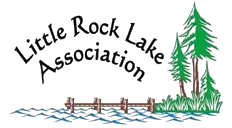What is a Lakeshore Buffer?
A lakeshore buffer is a restoration of a shoreline in order to correct an existing erosion problem or to improve the fisheries and water quality of the lake. At the heart of a lakeshore buffer concept is the creation of a buffer zone along the shoreline. A buffer zone is a strip of native vegetation along at least 75% of a property’s frontage. Buffers can extend a minimum of fifteen feet back from the lakeshore to be effective.
A natural shoreline is a complex ecosystem that sustains fish and wildlife and protects the entire lake. Native vegetation along the shore acts as a buffer zone, intercepting nutrients and reducing runoff, erosion, and sedimentation. Plants growing in and near the water are critical for wildlife and fish habitat and a healthy lakeshore.
Would you like assistance or literature for buffer maintenance?
The Little Rock Lake Association has books, web sites, and literature available on native plant identification and weed identification. We have a limited supply, but the books are free for the asking. These are excellent colored, glossy photos of native plants, of our area, to assist with your buffer maintenance. Members are available to provide assistance.

Buffer zones solve many problems for homeowners
- Emergent vegetation, like bulrushes and cattails, reduce shoreline erosion caused by wind and boat traffic.
- The natural vegetation serves as a filter strip that helps prevent lawn fertilizer and pesticide runoff from reaching the lake.
- Aquatic vegetation helps purify lake water by removing contaminants and by calming water, which allows suspended soil particles to settle to the lake bottom.
- Buffer zones reduce the amount of fertilizer and herbicide needed on a lakeshore property because the resulting lawn is smaller, and native plants in the buffer zone do not need fertilizer or herbicides.
- Buffer zones reduce the acreage of lawn and the amount of time needed for mowing and lawn maintenance.
- Unmowed wildflowers, grasses, and sedges along the shore create a biological barrier that will deter Canada geese from loitering on the lawn.
Since August 2009, the Little Rock Lake Association has partnered with the Benton County Soil and Water Conservation District (SWCD) on our Native Buffer Program. Members assist with the design, planning, planting, and maintenance of residential buffers around the lake and the Little Rock Channel.
Native Buffer Demonstration Site
A buffer strip demonstration site was planted around the pond in Benton Beach Park during the summer of 2009. If you have not seen a buffer strip, it is a planting of many native plant species on a strip of shoreline which will reduce runoff, erosion and sediment before it reaches the lake. The site includes educational signs explaining the type of buffer installed at the site. Please visit the demo site at Benton Beach Park if you’d like to see the real thing.
Benton Beach Pond
Buffer Demonstration Site Photos
Native Buffer Program Guidelines
The LRLA has embarked on a concerted effort to help lakeshore owners to plant and maintain buffer strips of native plants along their shoreline.
The Native Buffer Program is a voluntary program for people who want to improve water quality by establishing native grasses, flowers, or shrubs along their lakeshore. The program provides both technical assistance and may provide cost share to help establish a native buffer.The Little Rock Lake Association provides volunteers and workers to help install the buffer on planting day.
- The length of the shoreline buffer should preferably extend to cover 75% of the length along the shoreline. The access may be for a dock, sand beach, or other use.
- The minimum width of the native buffer must be at least 15 feet back from the water’s edge.
- The Native Buffer Program requires a diversity of 20 or more plant species. At least 50% of the total plants must consist of grasses and sedges.
- The native buffer must be installed and maintained for 10 years.
If you are interested in having a buffer strip designed and planted on your property, this spring and summer would be a great time to have it done! If you would like to become involved in reducing the pollution of Little Rock Lake and the channel by planting a buffer strip or need additional information, please call Nathan Sanoski at the Benton SWCD office 320-968-5300 Ext 3.
Let’s work together to continue the process of cleaning up our lake.
Site Recent Buffer Sites
On the right are Photos of recent buffer projects. These PDFs include before and after pictures. See how beautiful a lakeshore buffer can be.
If you are interested in having a buffer strip designed and planted on your property, this spring and summer would be a great time to have it done! If you would like to become involved in reducing the pollution of Little Rock Lake and the channel by planting a buffer strip or need additional information, please call Nathan Sanoski at the Benton SWCD office 320-968-5300 Ext 3, or Maureen Graber at 282-7113.
